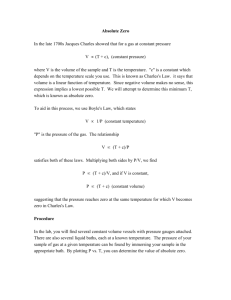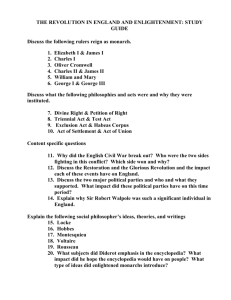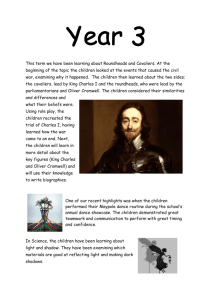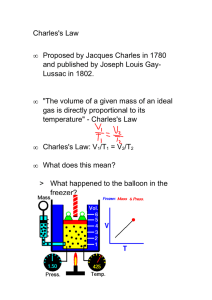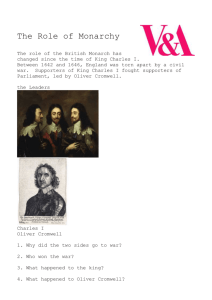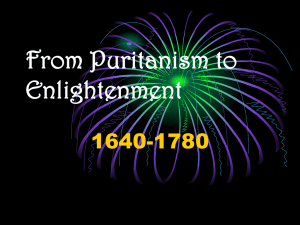King Charles II
advertisement
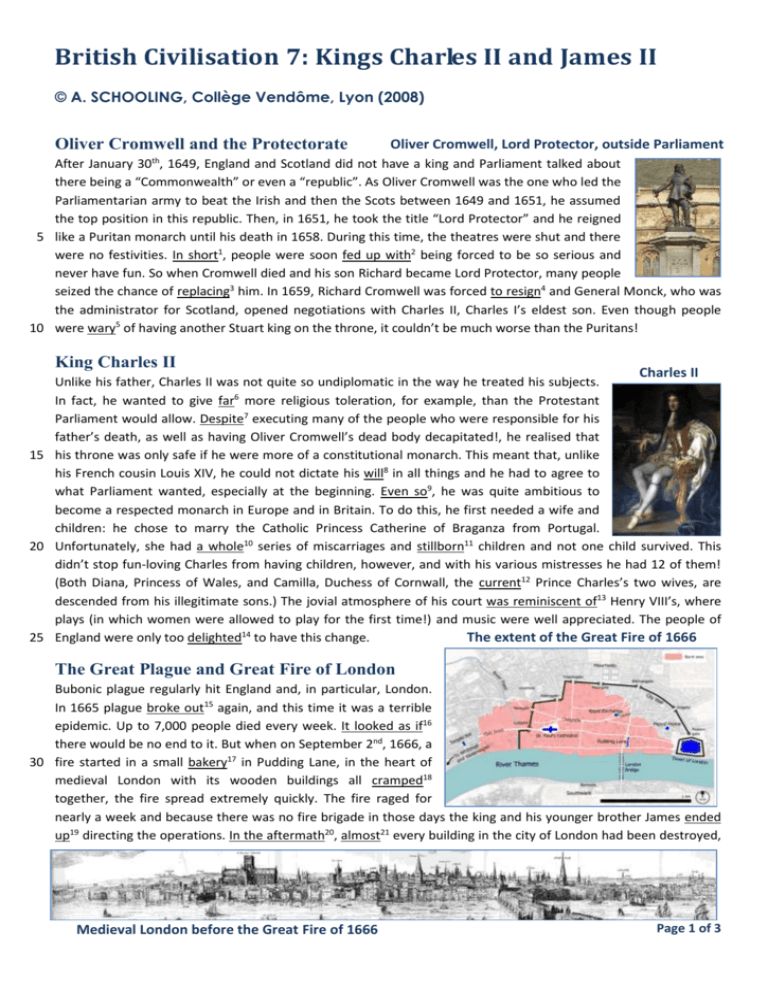
British Civilisation 7: Kings Charles II and James II © A. SCHOOLING, Collège Vendôme, Lyon (2008) Oliver Cromwell and the Protectorate Oliver Cromwell, Lord Protector, outside Parliament th After January 30 , 1649, England and Scotland did not have a king and Parliament talked about there being a “Commonwealth” or even a “republic”. As Oliver Cromwell was the one who led the Parliamentarian army to beat the Irish and then the Scots between 1649 and 1651, he assumed the top position in this republic. Then, in 1651, he took the title “Lord Protector” and he reigned 5 like a Puritan monarch until his death in 1658. During this time, the theatres were shut and there were no festivities. In short1, people were soon fed up with2 being forced to be so serious and never have fun. So when Cromwell died and his son Richard became Lord Protector, many people seized the chance of replacing3 him. In 1659, Richard Cromwell was forced to resign4 and General Monck, who was the administrator for Scotland, opened negotiations with Charles II, Charles I’s eldest son. Even though people 10 were wary5 of having another Stuart king on the throne, it couldn’t be much worse than the Puritans! King Charles II Charles II Unlike his father, Charles II was not quite so undiplomatic in the way he treated his subjects. In fact, he wanted to give far6 more religious toleration, for example, than the Protestant Parliament would allow. Despite7 executing many of the people who were responsible for his father’s death, as well as having Oliver Cromwell’s dead body decapitated!, he realised that 15 his throne was only safe if he were more of a constitutional monarch. This meant that, unlike his French cousin Louis XIV, he could not dictate his will8 in all things and he had to agree to what Parliament wanted, especially at the beginning. Even so9, he was quite ambitious to become a respected monarch in Europe and in Britain. To do this, he first needed a wife and children: he chose to marry the Catholic Princess Catherine of Braganza from Portugal. 20 Unfortunately, she had a whole10 series of miscarriages and stillborn11 children and not one child survived. This didn’t stop fun-loving Charles from having children, however, and with his various mistresses he had 12 of them! (Both Diana, Princess of Wales, and Camilla, Duchess of Cornwall, the current12 Prince Charles’s two wives, are descended from his illegitimate sons.) The jovial atmosphere of his court was reminiscent of13 Henry VIII’s, where plays (in which women were allowed to play for the first time!) and music were well appreciated. The people of 25 England were only too delighted14 to have this change. The extent of the Great Fire of 1666 The Great Plague and Great Fire of London Bubonic plague regularly hit England and, in particular, London. In 1665 plague broke out15 again, and this time it was a terrible epidemic. Up to 7,000 people died every week. It looked as if16 there would be no end to it. But when on September 2nd, 1666, a 30 fire started in a small bakery17 in Pudding Lane, in the heart of medieval London with its wooden buildings all cramped18 together, the fire spread extremely quickly. The fire raged for nearly a week and because there was no fire brigade in those days the king and his younger brother James ended up19 directing the operations. In the aftermath20, almost21 every building in the city of London had been destroyed, Medieval London before the Great Fire of 1666 Page 1 of 3 35 including St Paul’s Cathedral. But not everything was negative: the rats that had transmitted the plague were all killed and there was a chance to construct a cleaner city. However, because of property laws most of London was rebuilt in almost the same way22 as before, except that23 stone24 was used instead of25 wood, and thatch26 was forbidden. (In fact, until the Globe Theatre was rebuilt in 1997, it was illegal to use this material.) However, the one building that was dramatically changed was St Paul’s Cathedral. This was 40 redesigned27 by Sir Christopher Wren and, until the twentieth century, when skyscrapers28 in the City towered above29 it, it had dominated London’s skyline30 for more than two centuries. The famous dome of St Paul’s Foreign31 Policy Like his father and contemporary monarchs such as Louis XIV, Charles II dreamt of being a great conqueror. But with Africa and North America gradually being discovered, this inevitably led the main seafaring32 powers33 into conflict. Indeed, the British fought against the Dutch in three separate wars during Charles II’s reign, and it was at 45 this time that New Amsterdam was captured and renamed “New York” in honour of Charles’s brother James, Duke of York. In addition this, Charles also brought the Indian city of Bombay to Britain as part of his wife’s dowry34; the king allowed the creation of the East India Company, which could act as it wished35 without36 asking the king’s permission. This was because India was so far away and would have cost Charles too much money. In time, the success of this company enabled37 Britain to establish important trade links38 with the east and set up39 an empire. Parliament and the question of succession 50 When people saw that Charles II would have no heir, Parliament became worried that his brother James, a Catholic, would be like Mary Tudor. So they decided to reinforce a law called Habeas Corpus, which stated40 that nobody could be arrested without being accused of a crime before41 a judge and there had to be a proper42 trial43. Protestants were worried that the Duke of York would just arrest them, put them in prison and then execute them without trials. In fact, the bill44 should never have been passed: when the House of Lords voted on it in 1679, one of 55 the two Lords counting the votes saw another really fat Lord and for a joke counted “ten Lords” instead45; the other Lord counting was too drunk to notice46; nobody noticed that there were more votes than Lords present! The short reign of King James II James II’s statue in Trafalgar Square 47 60 65 70 75 48 In 1685, Charles II suddenly died, probably of kidney failure . He was succeeded by his younger brother. James had already had an affair with Charles’s leading minister’s daughter Anne Hyde and when she became pregnant in 1660 they were married. It shocked many people that he had not married royalty. Fortunately49, two of his eight children did survive; the elder daughter was called Mary,who later married Duke William of Orange in Holland, and the younger was called Anne, and they were brought up as Protestants. However, in 1673, two years after Anne Hyde died, James remarried the fifteen-year-old Catholic princess Mary of Modena. Now50, in this year James made public51 the fact that he had converted to Catholicism. James immediately faced52 two Protestant rebellions and although53 the king’s army led by John Churchill defeated these rebels, he quickly lost the support54 of important Protestants. In November 1685, he dissolved Parliament for the rest of his lifetime55, and he promoted Catholics to all the top positions in the country. Worse still56, he forced Anglican churchmen to read a statement57 that suggested that Catholicism was not wrong. But the final straw58 was when his wife Mary gave birth to a son and heir, James, in June 1688. This boy would be brought up59 a Catholic and Protestant leaders had had enough60: they entered into negotiations with Protestant Duke William of Orange and invited him to become king. Duke William arrived in 1688 on the famous Protestant day, November 5th, and the leading army officers like John Churchill abandoned King James II. In December, James fled to France, first throwing the Great Seal61 of the Realm62 into the River Thames in an attempt63 to prevent64 anyone else from reigning legally, but Duke William let him sail to Louis XIV, who supported him financially. James’s daughter Mary was proclaimed Queen Mary II and she reigned together with her husband, King William III. In England, this peaceful65 change of monarch was known as the “Glorious Revolution”. In reality, Parliament had Page 2 of 3 most power and they passed a Bill of Rights66 which, among other things67, stated that the English king could not be a Catholic or marry one. Nevertheless68, James II tried to get his throne back69 in 1689 and landed70 in Ireland which was mainly71 Catholic. Although James raised72 a large army, William’s troops defeated the Catholics at the Battle of 80 the Boyne on July 1st, 1690, and ever since Irish Protestants have celebrated King William by marching through the streets wearing orange sashes73. Poor James II returned to France and lived in the Château of Saint-Germain-en-Laye, near Paris and died there in 1701. England and Scotland, at least74, had decided to remain75 Protestant... Young Orangemen marching in Northern Ireland Kings Charles II and James II: Vocabulary Help 1. 2. 3. 4. 5. 6. 7. 8. 9. 10. 11. 12. 13. 14. 15. 16. 17. 18. 19. 20. 21. 22. 23. 24. 25. 26. 27. 28. 29. 30. 31. 32. 33. 34. 35. 36. 37. 38. in short = bref to be fed up with = en avoir marre de to replace = remplacer to resign = démissionner wary = méfiant, prudent far = beaucoup, de loin despite = malgré will = volonté even so = quand même a whole = toute une... (en entier) stillborn = mort-né current = actuel to be reminiscent of = rappeler, faire penser à delighted = ravi to break out = éclater it looked as if = on aurait dit que... bakery = boulangerie cramped = exigus, à l’étroit to end up (+ ing) = finir par in the aftermath = par la suite almost = presque way = façon except that = sauf que stone = de la pierre instead of = au lieu de thatch = chaume to (re)design = (re)concevoir, (re)dessiner skyscraper = gratte-ciel to tower above = dominer skyline = ligne de toits foreign = étrangère seafaring = de marins power = puissance dowry = dot to wish = souhaiter without = sans to enable = permettre trade links = liens commerciaux 39. 40. 41. 42. 43. 44. 45. 46. 47. 48. 49. 50. 51. 52. 53. 54. 55. 56. 57. 58. 59. 60. 61. 62. 63. 64. 65. 66. 67. 68. 69. 70. 71. 72. 73. 74. 75. to set up = créer, former to state = déclarer before (a judge) = devant (un juge) proper = vrai trial = procès bill = projet de loi instead = à la place to notice = remarquer kidney = rein, (ici) rénale failure = échec, (ici) défaillance fortunately = heureusement now = or (mot de liaison) to make public = rendre publique to face = se trouver face à although = quoique support = soutien lifetime = vie still = encore statement = déclaration the final straw = la goutte d’eau qui fait déborder le vase to bring (somebody) up = élever (qqn.) enough = assez seal = sceau realm = royaume attempt = tentative to prevent = empêcher peaceful = paisible Bill of Rights = déclaration des droits (d’un peuple) among other things = entre autres (choses) nevertheless = néanmoins to get something back = reprendre qqch. to land = atterrir mainly = pour la plupart to raise an army = lever une armée sash = écharpe at least = au moins, du moins to remain = rester Page 3 of 3


